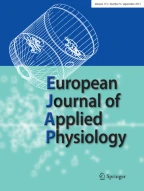Abstract
To clarify whether the resting background effects (genomic) or exercise-related action (non-genomic) of aldosterone (ALD) is primarily affected to an individual variation in the sweat Na+ concentration ([Na+]sweat), we analyzed the cross-sectional relationship between [Na+]sweat and the plasma ALD concentration during rest and exercise in a hot environment. Eleven college-aged male subjects with a mean maximal oxygen uptake of 48 (range 42–59) ml kg−1 min−1 performed three sessions of 20-min cycle exercise at two levels of intensity (40 or 60% \(\dot VO_{\rm 2max}\)) in a room maintained at 31°C. The chest sweat rate (SRch) and its containing Na+ were higher and individual differences in SRch and [Na+]sweat were greater at 60% exercise than at 40% exercise. In each individual, the [Na+]sweat increased significantly (P < 0.05) with the increase in the SRch. In all subjects, the mean [Na+]sweat during exercise correlated negatively with the resting plasma ALD level at either percentage, but it did not correlate with the exercising ALD. These results suggest that individual variations in the increase of the [Na+]sweat in response to a rise in the SRch may thus be more closely related to the resting ALD than to the exercising ALD. As a result, the genomic action of ALD may be affected more by the sweat Na+ variation than by the rapidly non-genomic action during exercise in humans.
Similar content being viewed by others
References
Allan JR, Wilson CG (1971) Influence of acclimation on sweat sodium concentration. J Appl Physiol 30:708–712
Allsopp AJ, Sutherland R, Wood P, Wootton SA (1998) The effect of sodium balance on sweat sodium secretion and plasma aldosterone concentration. Eur J Appl Physiol 78:516–521
Brožek J, Grande F, Anderson JT, Keys A (1963) Densitometric analysis of body composition: revision of some quantitative assumptions. Ann N Y Acad Sci 110:113–140
Collins KJ (1966) The action of exogenous aldosterone on the secretion and composition of drug-induced sweat. Clin Sci 30:207–221
Elkinton JE, Danowski TS, Winkler AW (1946) Hemodynamic changes in salt depletion and dehydration. J Clin Invest 25:120–129
Francesconi RP, Sawka MN, Pandolf KB (1983) Hypohydration and heat acclimation: plasma renin and aldosterone during exercise. J Appl Physiol 55:1790–1794
Freund BJ, Shizuru EM, Hashiro GM, Claybaugh JR (1991) Hormonal, electrolyte, and renal responses to exercise are intensity dependent. J Appl Physiol 70:900–906
Fujimoto S, Watanabe T (1969) Studies on the body surface area of Japanese. Acta Med Nagasaki 14:1–13
Hanane R, Flandrois R, Charbonnier JP (1977) Increase in sweating sensitivity by endurance conditioning in man. J Appl Physiol 43:822–823
Harvey BJ, Higgins M (2000) Nongenomic effects of aldosterone on Ca+ in M-1 cortical collecting duct cells. Kidney Int 57:1395–1403
Hegarty JM, Harvey BJ (1998) Aldosterone increases intracellar calcium in cultured human sweat gland epithelial cells by non-genomic mechanism of action. J Physiol (Lond) 511P:36P
Hegarty JM, Harvey BJ (1999) Aldosterone accelerates a Na+/H+ exchange dependent pH recovery after acid loading in cultured human eccrine sweat gland epithelial cells. J Physiol (Lond) 517P:20P
Kirby CR, Convertino VA (1986) Plasma aldosterone and sweat sodium concentrations after exercise and heat acclimation. J Appl Physiol 61:967–970
Maguire D, MacNamara B, Cuffe JE, Winter D, Doolan CM, Urbach V, O’Sullivan GC, Harvey BJ (1999) Rapid responses to aldosterone in human distal colon. Steroids 64:51–63
Morgan RM, Patterson MJ, Nimmo MA (2004) Acute effects of dehydration on sweat composition in men during prolonged exercise in the heat. Acta Physiol Scand 182:37–43
Nagamine S, Suzuki S (1964) Anthropometry and body composition of Japanese young men and women. Hum Biol 36:8–15
Nose H, Takamata A, Mack GW, Oda Y, Okuno T, Kang D, Morimoto T (1991) Water and electrolyte balance in the vascular space during graded exercise in humans. J Appl Physiol 70:2757–2762
Ohara K (1966) Chloride concentration in sweat; its individual, regional, seasonal and some other variations, and interrelations between them. Jpn J Physiol 16:274–290
Robinson S, Robinson AH (1954) Chemical composition of sweat. Physiol Rev 34:202–220
Sato K (1977) The physiology, pharmacology, and biochemistry of the eccrine sweat gland. Rev Physiol Biochem Pharmacol 79:51–131
Sato K, Dobson RL (1970) The effect of intracutaneous d-aldosterone and hydrocortisone on human eccrine sweat gland function. J Invest Dermatol 54:450–462
Sawka MN, Wenger CB, Pandolf KB (1996) Thermoregulatory responses to acute exercise-heat stress and heat acclimation. In: Blatteis CM, Fregly MJ (eds) Handbook of physiology, section 4: Environmental Physiology. Oxford University Press for the American Physiological Society, New York, pp 157–186
Senay LC, Mitchell D, Wyndham CH (1976) Acclimatization in a hot, humid environment: body fluid adjustments. J Appl Physiol 40:786–796
Shapiro Y, Hubbard RW, Kimbrough CM, Pandolf KB (1981) Physiological and hematologic responses to summer and winter dry-heat acclimation. J Appl Physiol 50:792–798
Verde T, Shephard RJ, Corey P, Moore R (1982) Sweat composition in exercise and in heat. J Appl Physiol 53:1540–1545
Wehling M (1997) Specific, nongenomic actions of steroid hormones. Ann Rev Physiol 59:365–393
Author information
Authors and Affiliations
Corresponding author
Rights and permissions
About this article
Cite this article
Yoshida, T., Shin-ya, H., Nakai, S. et al. Genomic and non-genomic effects of aldosterone on the individual variation of the sweat Na+ concentration during exercise in trained athletes. Eur J Appl Physiol 98, 466–471 (2006). https://doi.org/10.1007/s00421-006-0295-5
Accepted:
Published:
Issue Date:
DOI: https://doi.org/10.1007/s00421-006-0295-5
